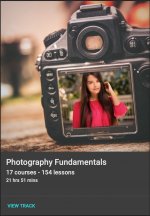I know what you mean. The manual for my Canon 5D Mark IV is 676 pages! There is a section in the front called "Getting Started" which outlines the technical things you need to get started operating the camera, but it doesn't have anything in it about basics of photography. Luckily my camera has a menu system that is very well thought out and functions are organized into logical groups, but there was still a pretty steep learning curve as it's a complex beast that doesn't lend itself to a simple manual.
For most of my learning I have often relied on various tutorials, usually in the form of online courses I've purchased. I also belong to KelbyOne, Scott Kelby's online community (a paid membership), which has hundreds of excellent, professional produced courses, with many different professional as instructors. Kelby. The courses are grouped into "Tracks" where a track might have several courses that are of related topics and each course will have many lessons. Here's an example:
View attachment 81459
As you can see, this Track on Photography Fundamentals has 17 separate courses (things like
"The Twenty Time Proven Rules of Composition," "Lenses: Accessories Basics," "Light, the Main Element in Every Photograph," just to name a couple.
Each of the courses will have several "lessons."
You don't have to take the entire track if you don't need to, you can pick and choose what you want to learn about. It's a really great learning environment they have put together.

 Hi Guest!
Hi Guest!

 smilie in place of the real @
smilie in place of the real @
 Pretty Please - add it to our Events forum(s) and add to the calendar! >>
Pretty Please - add it to our Events forum(s) and add to the calendar! >> 


